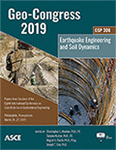Eighth International Conference on Case Histories in Geotechnical Engineering
Centrifuge Investigation of the Effects of Liquefiable Soil Interlayering and Structural Strength on the Seismic Performance of Soil-Structure Systems
Publication: Geo-Congress 2019: Earthquake Engineering and Soil Dynamics (GSP 308)
ABSTRACT
This paper discusses the results of dynamic centrifuge tests performed on 9-story model structures with different yield capacities founded on a layered liquefiable deposit with and without a silt cap. The goal was to evaluate the interacting role of soil interlayering and structure’s yield capacity on the response of soil-foundation-structure systems. The first test evaluated the seismic performance of a 9-story, steel, moment-resisting frame structure (B1) on a layered liquefiable deposit without a silt cap. The second test simulated simultaneously two models of a 9-story structure (B1 and B2) on a similar soil profile, but with a silt cap. Structure B2 was designed to have a greater yield capacity compared to B1, with other dynamic properties kept constant. The presence of a silt cap and resulting void redistribution did not notably change Structure B1’s average settlement, but it amplified residual rotations, foundation, and roof accelerations, and deformation demands on the superstructure. The stronger Structure B2 also experienced large rotations but less than B1, because of smaller flexural deflections and P-Δ moments imposed about its columns and foundation. These results point to the importance of characterizing soil interlayering as well as structure’s strength and other dynamic properties when evaluating the consequences of liquefaction.
Get full access to this article
View all available purchase options and get full access to this chapter.
ACKNOWLEDGMENTS
This material is based upon work supported in part by the National Science Foundation (NSF) under Grant No. 1362696. Any opinions, findings, and conclusions or recommendations expressed in this material are those of the authors and do not necessarily reflect the views of the NSF. The authors would also like to thank Dr. Peter Kirkwood, Mr. Mahir Badanagki, and Dr. Juan Olarte for their assistance in centrifuge model preparation and testing.
REFERENCES
Andrus, R. D., and Stokoe, K. H. II., and Roesset, J. M. (1991). “Liquefaction of gravelly soil at Pence Ranch during the 1983 Borah Peak, Idaho earthquake.” Proc., of Fifth Int. Conf. on Soil Dynamics and Earthquake Engineering Karlsruhe, Germany, 251-262.
Badanagki, M., Dashti, S., and Kirkwood, P. (2018). “An experimental study of the influence of dense granular columns on the performance of level and gently sloping liquefiable sites.” J. Geotech Geoenviron Eng., 144(9), https://doi.org/10.1061/(ASCE)GT.1943-5606.0001937
Cubrinovski, M., Rhodes, A., and Ntritsos, N. (2017). “System response of liquefiable deposits.” 3rdInt. Conf. on Performance-based Design in Earthquake Geotechnical Engineering Vancouver, Canada.
Dashti, S., Bray, J., Pestana, J., Riemer, M., and Wilson, D. (2010a). “Mechanisms of seismically induced settlement of buildings with shallow foundations on liquefiable soil.” J. Geotech. Geoenviron. Eng., 136(1), 151-164.
Dobry, R., and Liu, L. (1992). “Centrifuge modeling of soil liquefaction.” Proc., 10thWorld Conf. on Earthquake Engineering, Madrid, Spain, 6801-6809.
Fiegel, G. L., and Kutter, B. L. (1994). “Liquefaction mechanism for layered soils.” J. Geotech. Eng., 120(4), 737-755.
Ishihara, K. (1985). “Stability of natural deposits during earthquakes.” Proc., 11thInt. Conf. on Soil Mechanics and Foundation Engineering, A. A. Balkema Publishers, Rotterdam, The Netherlands, 321-376.
Kirkwood, P., and Dashti, S. (2018). “A centrifuge study of seismic structure-soil-structure interaction on liquefiable ground and implications for design in dense urban areas.” Earthquake Spectra https://doi.org/10.1193/052417EQS095M.
Kokusho, T. (1999). “Water film in liquefied sand and its effect on lateral spread.” J. Geotech. Geoenviron. Eng., 125(10), 817–826.
Kokusho, T., and Fujita, K. (2001). “Water films involved in post-liquefaction flow failure in Niigata City during the 1964 Niigata earthquake.” Proc., Fourth Int. Conf. on Recent Advances in Geotechnical Earthquake Engineering and Soil Dynamics Univ. of Missouri-Rolla, Rolla, Mo.
Kulasingam, R., Malvick, E.J., and Boulanger, R.W. (2004). “Strength loss and localization at silt interlayers in slopes of liquefied sand.” J. Geotech. Geoenviron. Eng., 130(11), 1192-1202.
Liu, H., and Qiao, T. (1984). “Liquefaction potential of saturated sand deposits underlying foundation of structure.” Proc., 8th World Conf. on Earthquake Engineering San Francisco, 199-206.
Olarte, J. C., Dashti, S., and Liel, A. B. (2018). “Can ground densification improve seismic performance of the soil-foundation-structure system on liquefiable soils?” Earthquake Eng Structural Dyn., 47(5), 1193-1211.
Olarte, J. C., Paramasivam, B., Dashti, S., Liel, A. B., and Zannin, J. (2017). “Centrifuge modeling of mitigation-soil-foundation-structure interaction on liquefiable ground.” Soil Dyn. Earthquake Eng., 97(6), 304-323.
Paramasivam, B., Dashti, S., and Liel, A. B. (2018). “Influence of prefabricated vertical drains on the seismic performance of structures founded on liquefiable soils.” J. Geotech Geoenviron Eng., 144(10), https://doi.org/10.1061/(ASCE)GT.1943-5606.0001950.
Ramirez, J., Barrero, A., Chen, L., Dashti, S., Ghofrani, A., Taiebat, M., and Arduino, P. (2018). “Site response in a layered liquefiable deposit: Evaluation of different numerical tools and methodologies with centrifuge experimental results.” J. Geotech Geoenviron Eng., 144(10), https://doi.org/10.1061/(ASCE)GT.1943-5606.0001947.
Information & Authors
Information
Published In
Geo-Congress 2019: Earthquake Engineering and Soil Dynamics (GSP 308)
Pages: 66 - 75
Editors: Christopher L. Meehan, Ph.D., University of Delaware, Sanjeev Kumar, Ph.D., Southern Illinois University Carbondale, Miguel A. Pando, Ph.D., University of North Carolina Charlotte, and Joseph T. Coe, Ph.D., Temple University
ISBN (Online): 978-0-7844-8210-0
Copyright
© 2019 American Society of Civil Engineers.
History
Published online: Mar 21, 2019
Published in print: Mar 21, 2019
ASCE Technical Topics:
- Centrifuges
- Construction equipment
- Earthquake engineering
- Earthquake resistant structures
- Engineering fundamentals
- Equipment and machinery
- Geomechanics
- Geotechnical engineering
- Seismic tests
- Silt
- Soil liquefaction
- Soil mechanics
- Soil properties
- Soil strength
- Soil structures
- Soils (by type)
- Structural behavior
- Structural engineering
- Structural strength
- Structures (by type)
- Tests (by type)
Authors
Metrics & Citations
Metrics
Citations
Download citation
If you have the appropriate software installed, you can download article citation data to the citation manager of your choice. Simply select your manager software from the list below and click Download.
